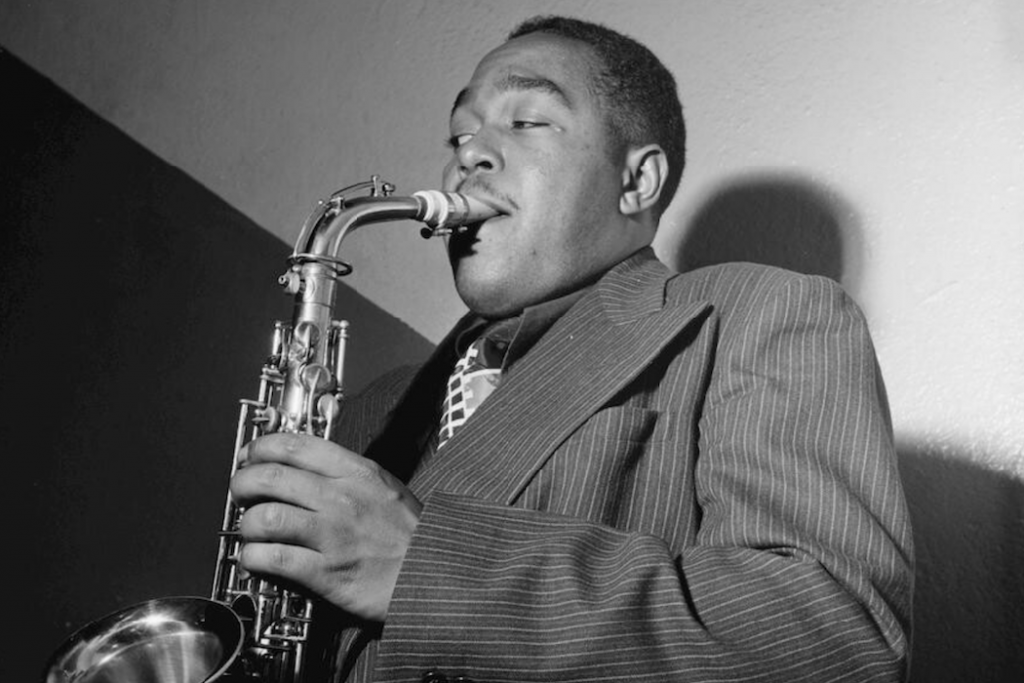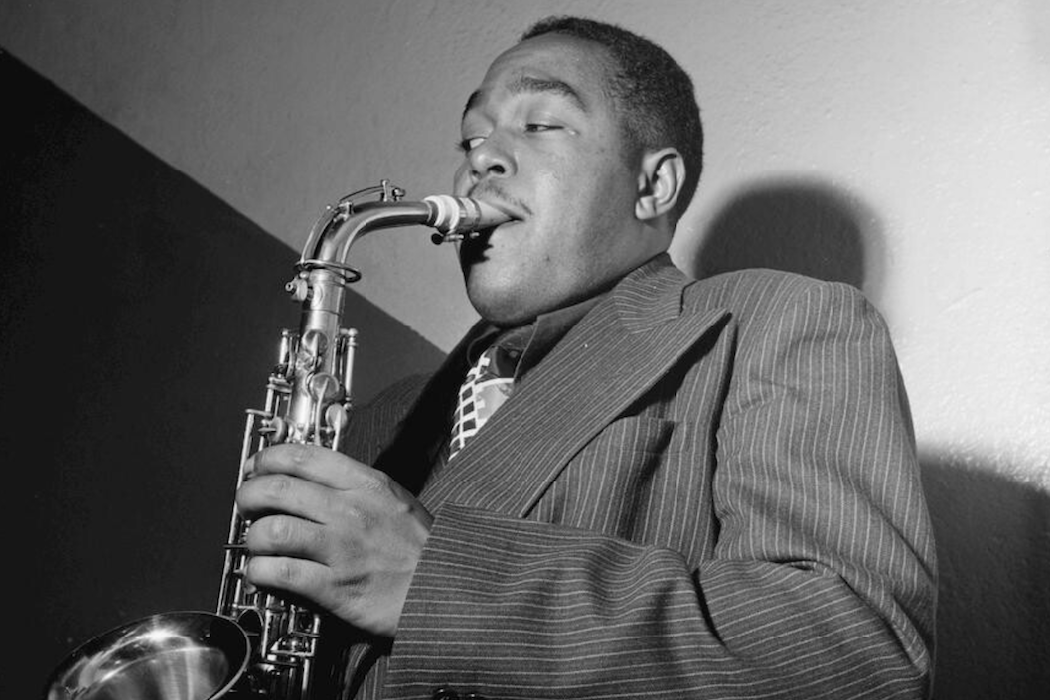
+ Welcome to Soundfly! We help curious musicians meet their goals with creative online courses. Whatever you want to learn, whenever you need to learn it. Subscribe now to start learning on the ’Fly.
The 12-bar blues is the most important structural element in the history of American popular music. Musicians from Louis Armstrong to The White Stripes have used the form as a canvas for improvisation, with each artist offering a unique approach to a simple, 48 beat pattern. Too often, however, musicians revert to the minor pentatonic scale and shred patterns during solos when they could be illustrating more difficult harmonic concepts that expose the hidden complexity of the blues.
The inherent simplicity in the blues form offers artists freedom to modify and add to the blues, and these transformations are what make each version of the blues sound different. Thankfully, not all of these transformations are as complex as they sound.
In this article, I’ll guide you through a number of ways musicians have altered or added to the basic harmonic structure of the 12-bar blues and suggest some ways you can spice up your next solo or composition instead of depending on the trusty blues scale.
Brush up on the basics of the blues form with this excerpt from our free course, “A Conversation with the Blues.”
The Basics
The 12-bar blues is built in three phrases, harmonically marked by shifts in the first two bars of each phrase. The first phrase remains entirely in the tonic key. The second shifts to the subdominant, then returns to the tonic. The third phrase shifts to the dominant before returning home to the tonic. Here is the most basic version of blues harmony:

This is a classic progression, but it isn’t very complex. Luckily, we can add a lot to that simple chord progression. The most common alteration to the blues transforms measure 10 to briefly return to the IV chord, and creates a sense of forward motion by including a V7 chord in measure 12 to naturally lead listeners to the top of the form:
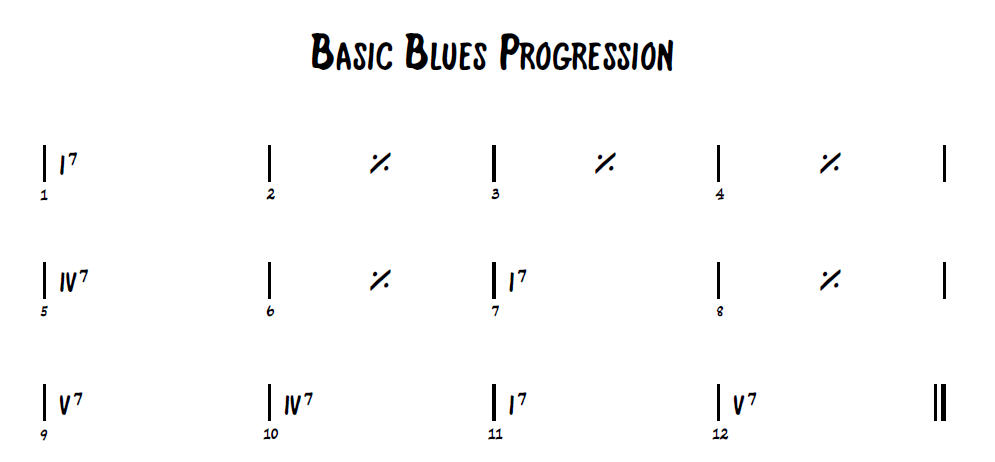
Most musicians refer to this as the “standard” progression and it is commonly used in classic blues recordings by Robert Johnson and Blind Lemon Jefferson (and by musicians influenced by these classic recordings in later eras — think Buddy Guy and Eric Clapton). But V7–IV7 isn’t much of a cadence. Jazz musicians often strengthen the cadence in measures 9 and 10 by making it a ii7–V7 progression. Reversing the order of the dominant and subdominant functions in these measures makes the phrase sound more like a jazz standard and reinforces the sense of finality provided by the I7 chord in measure 11. Examples of this progression include Charlie Parker’s “Now’s the Time” and Sonny Rollins’ “Tenor Madness.”

Of course, it’s possible to push the envelope in these measures. Brian Wilson merges the jazz approach with the classic approach in the last phrase of the Beach Boys’ “Little Deuce Coupe”:

This approach not only illustrates Wilson’s willingness to break the rules, but also demonstrates how much harmonic variation is possible in these measures of a blues form. Virtually any material that leads to the I7 chord in measure 11 will work — and if you’re really willing to commit, you can even ignore that. The more adventurous the composer, the crazier they’re likely to get. Ornette Coleman, for example, gets downright weird in “Turnaround”:

The first lesson, as always, is that Ornette Coleman has no limits. The second lesson is that as long as you preserve some idea of a tonic function (even something in second inversion, as Coleman does) in measure 11, you can probably get away with insanity in measures 9 and 10.
“Extra” Changes
Although measures 9 and 10 offer a lot of room for experimentation, not all of us are Ornette Coleman, and there are plenty of other ways to add harmonic complexity to the blues. Virtually every two measure chord can be preceded with a ii7–V7 progression to tonicize the new key center:

This approach (common in jazz) smooths out the dissonance built into the blues by the constant dominant chords by centering each one in a tonal system. An even more advanced approach could include using tritone substitutions. Tritone subs will provide a similar “lead in” to the new chords in measures 5 and 9, but by stepping down chromatically:
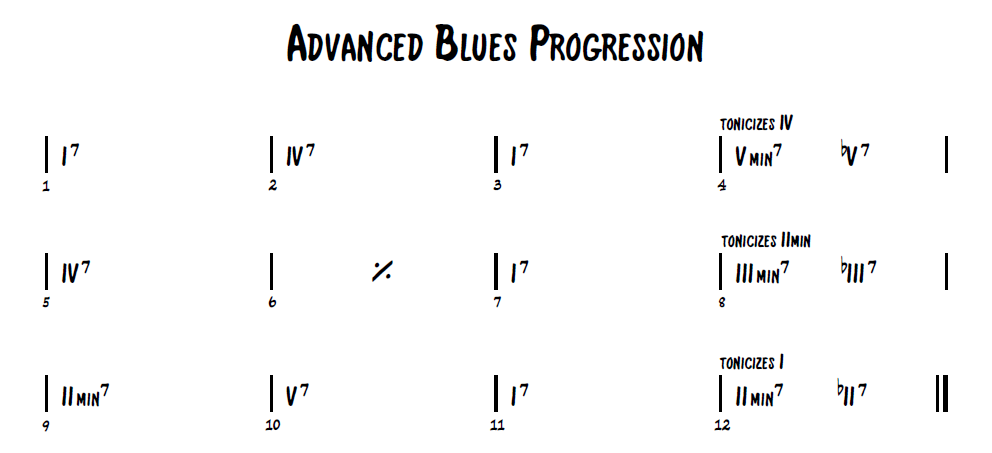
Harmonies can also be added in other places. For example, the second measure of the form is a common place to add an extra IV7 chord (as in the above examples). This is standard practice in many blues styles because it reminds listeners that this is indeed a blues (it foreshadows the I7–IV7 motion in measures 4–5) and offers some variety in the first phrase, which can otherwise be harmonically stale.
Changing the System
Some variations on the blues involve transforming the entire system away from the dominant 7th chord. Rather than focusing on I7 and IV7, these approaches choose alternative modes or even progressions more common in particular styles.
Many jazz standards are based on a version of the blues form built in a minor key. Notice that a minor blues is built on the same basic tonic relationships as a standard blues, but translated into a minor mode:
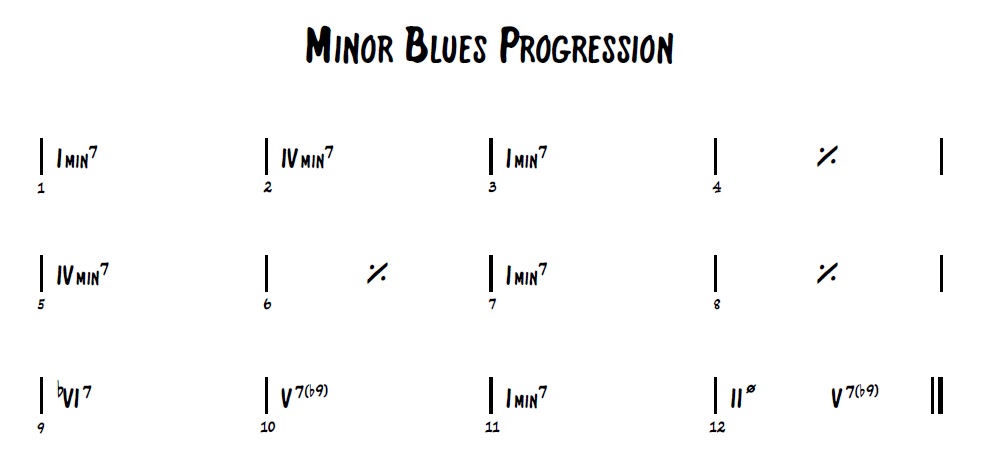
Minor blues forms are less dissonant than standard blues forms. The tension that results from moving between a major third (on the I7 chord) and a minor third (the 7th of the IV7 chord) disappears because of the minor mode. However, many of the same alterations common in standard blues forms are also possible in a minor blues.
Measure 9 is still fulfilling a subdominant function, but why would this version of the blues choose a ♭VI7 chord instead of the standard iv or ii chords? ♭VI7 feels subdominant (it includes some of the same chord tones as a ii7 chord), and also sets up the V7 chord in measure 10 (via a tritone substitution). Other harmonies in measure 9 are of course possible. Tonicizing measure 5 and measure 9 are still common as well.
Another possible modal shift involves replacing all the dominant 7th chords with suspended chords. This creates a hollow, modern sound and gives the soloist the freedom to imply their own major-minor relationships with their melodic choices. Tonicizing measure 5 and measure 9 are less common when using sus chords. In addition, the hollow, open harmony can offer more freedom for unusual melodic choices in measures 9 and 10.

A blues system popularized by Charlie Parker on “Blues for Alice” takes the idea of tonicization even further by introducing more of the circle of fifths:

In the first phrase, Parker starts by modifying measure 4 to help tonicize and set up the shift to IV in measure 5, as we discussed earlier. Parker then takes the idea even further, using measure 3 to tonicize measure 4, and measure 2 to tonicize measure 3. The result is a long trip through the circle of fifths. To tie things together, Parker changes measure 1 to a major mode rather than the dominant mode using a I6 chord. The result is a first phrase that sounds more like bebop than the blues.

In the second phrase, Parker does much the same thing — measure 6 sets up measure 7, which sets up measure 8, which sets up measure 9. This time, however, Parker uses a complex system of tritone substitutions and secondary dominants to set up the next chord in the progression (rather than the simple circle of 5ths in measures 2–4).
Before we break things down further, it’s worth remembering that in Parker’s bebop world, a key can always be implied by a ii7–V7 progression — even if that key is only “supposed” to be one chord for one measure. When Parker looks at the ii7–V7 progression in measures 9 and 10 that are part of a standard jazz blues, he says “oh, that whole thing is just a I chord, because that’s what the ii7–V7 implies.”
Typically, when an artist wants to tonicize measures 9–10, the goal is to tonicize ii. Parker wants to tonicize I instead. Therefore, Parker uses measure 8 to tonicize it. Typically, we’d use a V7 chord, but Parker uses a tritone substitution.
He repeats the process twice more, using a tritone substitution in measure 7 to set up measure 8 and the same thing in measure 6 to set up measure 7. This would result in the following progression (remembering that the IV7 chord in measure 5 is a “blues anchor point”):

Then, Parker goes even further. Unsatisfied with a series of chromatic dominant 7th chords, he then makes each of his tritone substitutions a key center by spending the bar implying the substitution with a ii7–V7 progression in that key:

It’s an effective progression. The chromatic walk-down in measures 6–8 sets up a feeling of forward motion that distracts listeners from just how removed Parker has become from a traditional blues. Happily, the third phrase is fairly standard — Parker merely uses measure 11 to set up a circle of fifths progression back to the top of the form.
There are a couple important things to take away from Parker’s harmonic gymnastics. First, although his progression is drastically different than a standard blues, he arrived at the new progression by following the same principles I’ve been discussing throughout this article. He uses the harmony in a particular measure to set up the following measure and uses tritone substitutions to make those tonicizations more complex — but takes this approach to the extreme.
Second, despite all the modifications Parker makes to a standard blues form, it still sounds like the blues. He anchors the form in measures 1, 5, and 9–12 with typical harmonies so that listeners stay grounded in the standard approach to the blues.
Is There Room for the Blues Scale?
Of course, all these advanced approaches to harmony make it easy to lose track of the simple, fun nature of the blues. Compositions and solos should only feel like solving Sudoku puzzles if that’s what you want or intend. Don’t be afraid to use a blues scale when the style, the piece, or your musical mood calls for it.
Some of these transformations (such as using sus chords) actually lend themselves to a minor pentatonic melody quite well. The opposite approach also works. Imply some tritone substitutions over the second phrase of standard blues harmony and you’ll end up sounding like an advanced bebop player. Experiment with various combinations and enjoy the many possibilities the blues has to offer.
Want to get all of Soundfly’s premium online courses for a low monthly cost?
Subscribe to get unlimited access to all of our course content, an invitation to join our members-only Slack community forum, exclusive perks from partner brands, and massive discounts on personalized mentor sessions for guided learning. Learn what you want, whenever you want, with total freedom.
